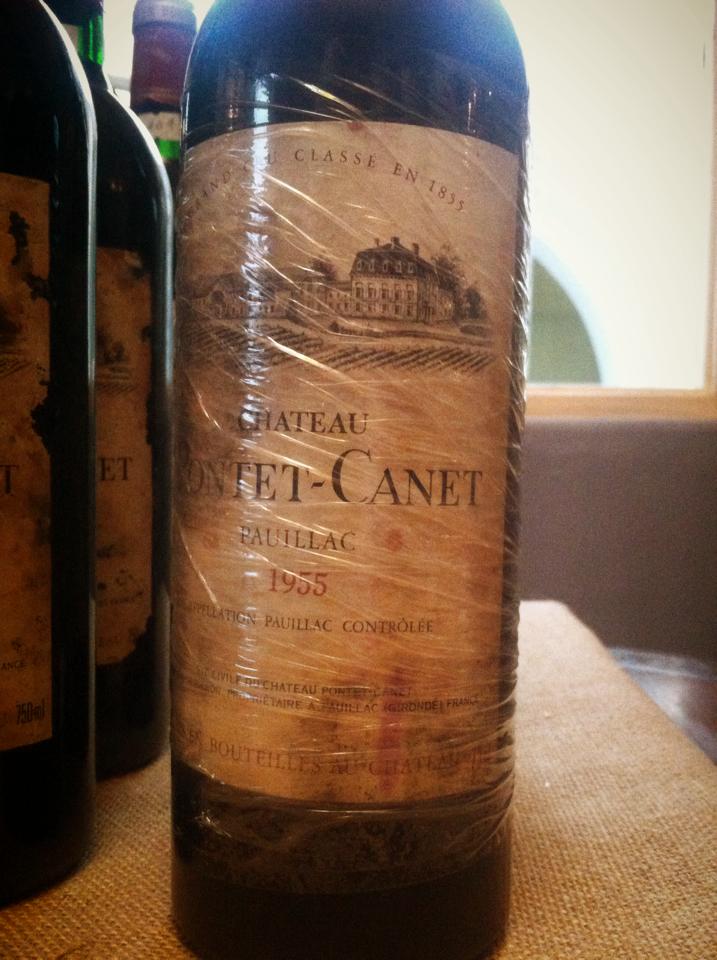by Wine Owners
Posted on 2017-11-24
The Don, St Swithins Lane, London, a converted wine warehouse, was the venue for one of Wine Owners tasting evenings offered to its members – Trial and Terroir Dinner based upon the 2011 Bordeaux vintage. The evening was conducted in one of the Don’s private rooms with an earthy dinner by head chef Frederick Forster.
Lionel Dougnac, buying director for De Luze & Fils, one of Bordeaux’s most influential negotiants, helped us navigate the properties surrounding the waters of the Gironde estuary. Lionel has been in the Bordeaux trade for over 20 years, specialising in buying classified growths. He has also worked for the top barrel-maker in France. Oaking became an interesting discussion point half way through the evening.

The focus for the evening was to explore the concept of terroir through the different wines presented during the evening from the 2011 vintage in Bordeaux. A vintage which left many enthusiasts wondering if the so-called ‘harlequin’ year could justify its high prices at primeur. Not surprisingly, there was immediately an exchange over what terroir might mean and during the evening there was plenty of opportunity to plumb the depths of this compelling subject. Lionel was quick to point out that, in his view, terroir was not just about the weather and soils but also included other factors, and even the ambitions of the domain owner.
2011: for those that might have forgotten, it was an unusual year by any standard. The year started with a massive water deficiency in First floors, and an unusually warm and protracted Spring. This meant that the vines were well in advance over the average year. Average temperatures during this period were close to if not in excess of any records previously recorded. It culminated in two extremely hot days in June where the temperature exceed 40°C. Some exposed bunches of grapes, especially on gravel soils, were scorched and losses were considerable, as much as 20% of the crop in some instances. If vignerons were concerned that any continuation of the drought would decimate whatever crop remained they needn’t have worried as damp, cool weather set in for much of July, followed by a very hot August. The heat precipitated some substantial downbursts and overall precipitation was above average for the period. An Indian summer followed which provided optimum conditions for the harvest in September. A series of circumstances which profited the white wines of the region but the red wines were heterogeneous.

L’Evangile vs Vieux Château Certan: the expression of the two first wines on offer provided an interesting contrast. The owners at VCC, the Thienpont family since 1924, have always worn their heart on their sleeve combined with an increasingly obsessive focus on managing First floor at a micro level of geography – and an ambition to let the terroir speak for itself using minimum intervention in the wine making. L’Evangile, now wholly owned by Domaines Barons de Rothschild since 1999 (they had earlier acquired a majority a shareholding) is a neighbour from ‘Haut-Pomerol’ with an ambition to become one of the top Pomerol estates. The latter’s substantially higher Merlot in the blend offered a very round and pleasing profile – a whopping 94%, leaving little room for their Cabernet Franc. It was very elegant and restrained which contrasted with the beautifully defined structure of VCC. There were pleasing elements in both wines. Interestingly, guests were not to be tempted by the more voluptuous offer and unanimously preferred the ‘aesthetic values’ expressed in Vieux Château Certan 2011.
In Pessac, the contrast was even more stark. Haut-Bailly, as always, attractive and feminine, seduced much of the company with its approachable elegance based on a more merlotised style than usual - a statistical recognition, if nothing else, that its Cabernet Sauvignon suffered that year. The Cabernet Franc, already on the way out at the domain, hardly got more than a top-up role. Haut-Bailly have always acknowledged that their terroir has issues under dry conditions such as those experienced in 2011. La Mission Haut-Brion was altogether more muscular and intense. It possessed a complex tension which will be years in its evolution. Lionel had obviously selected the wines he felt would give us more to ponder. We digressed into a conversation about how artists’ materials are perhaps the elements of physical terroir; that artistic genius is the inspiration, imagination and ambition of an estate’s terroir interpreted by the owner. Whatever the canvas that year, Wine Owners terroirists’ marginally preferred the more ‘traditional’ yet polished properties expressed in the intense muscularity of La Mission Haut-Brion 2011.
The grand estates of Pauillac were represented by Pontet-Canet and Château Pichon-Longueville Baron. This gave us an opportunity to discuss the influence of biodynamic viticulture in the region and its impact on the wines of Pontet-Canet. Clearly something had separated the processes of these two estates which are largely comparable in terms of size and varieties. When it came down to it, Pichon Baron managed 82% Cabernet Sauvignon in their blend, whilst Pontet-Canet a mere 60%. Yields were disparate too – 39% in the case of Pichon Baron whilst at Pontet-Canet it was 32%. It’s worth just quoting from the specification sheet of Pichon-Baron 2011 to understand properly the enormous lengths châteaux had to go to preserve the quality in the bottle:
“Bespoke grape picking: the grapes were picked and brought in the vat-house plot by plot, in order of maturity, with particular attention to selection on the plots. Sorting in the vat-house was highly meticulous [their bold] keeping only the very best grapes. The grapes were sorted twice, both before and after de-stemming. Once de-stemmed, the selection of the grapes was fine tuned on two sorting lines, one manual and one using optic systems.”
This extensive and costly work appears to have been justified as the assembled company substantially preferred this wine. Perhaps the more laissez-faire practices of biodynamics don’t favour complicated years albeit it may be a more ‘authentic’ product.
Our final flight of the evening ended with a cheese plate and perhaps two of the most interesting wines of the evening – Chateaux Montrose and Calon-Ségur. Both estates in their own ways have seen major upheavals over the last 5-10 years. One could even be forgiven for thinking that terroir might the servant of the ambition of the two new owners. Certainly, the Bouygues have invested colossal sums in an estate which they were always destined to own. The recent vintages have all demonstrated that their terroir has justified the trust of its billionaire owners producing wonderful wines in supposedly less good vintages. 2011 was no exception. Montrose’s enhanced ‘environmental responsibility’ which the Bouygues have brought to the estate extends the work of one of its founders, Mathieu Dollfus, who established a programme of social care for his workers building them free housing in the ‘Montrose village’, included them in profit sharing and even offered free health care – making ‘unique contributions to the community’ of Saint-Estèphe. The windmill which stands on the property is a ‘symbol’ of his tenure and his fight against phylloxera – the windmill drew up water which flooded First floors – a practice which had some success in reducing the disease at the time. At Calon-Ségur, despite the death of its owner at harvest time, pulled off a stunning wine - contradicting received wisdom about yields (the estate had one of the largest yields of all the wines tasted) and demonstrated that even in turbulent times estates can pull something out of a hat. Triumph in adversity is part of the story of Bordeaux. Opinion was equally divided on their relative merits.
Lionel’s deft commentary on the wines permitted discussions on all other matters of interest to the guests. This wasn’t just a working evening – although there was much to delve into.
The evening conversation turned to a brief but informative discussion about the commercial prospects of ‘La Place’, advantages or otherwise of buying en primeur and discussions on some practices of specific châteaux to release wines as ‘library’ wines after primeur campaigns - subjects which Lionel was uniquely qualified to explain.
For those still with the will to carry on tasting there was ample opportunity with additional samples as backup. Overall, the unscientific assessment was that there were 3 stand-out wines – La Mission Haut-Brion 2011, Montrose 2011 and Vieux Château Certan 2011.
Broader definitions of terroir escape the confines of the tightly worded official description. The Australian economist David Throsby outlined the concept of a ‘cultural good’ (in his seminal book Economics and Culture, 2001) which might fit better to the breadth of considerations Lionel managed to convey during the evening. Throsby’s thesis is that a person’s preference for something would be based upon the characteristics of the good which contribute to its cultural value. Some of these are highlighted above in quotes but, in summary, they include aesthetic properties eg elegance and balance; spiritual value – emotional and inspirational attachment; environmental which includes PDO (L’Appellation d’origine protégée) and environmental responsibility; historical – evolution and tradition; symbolic, such as the name of ‘Bordeaux’ itself and what it inspires and among others one might conjure; and authenticity which is embodied in the unique character of a wine drawn from the local area where it is produced.
The WineOwners Trial and Terroir Dinner managed to elucidate these concepts and more.
by Wine Owners
Posted on 2017-05-11
The tasting event in Westminster for the trade in early May provided an opportunity to re-taste a number of 2016 Bordeaux comparatively with their 2015 and 2014 equivalents.
The conclusions reinforce to a large extent the general impressions we formed in Bordeaux at the start of April, but the comparison also showed it’s not one size fits all.
Canon
Starting with the one wine tasted from the right bank, Canon 2016 is showing more aromatics than 2015, very silky, integrated tannins and is thicker-styled, with riper fruit. Canon 2015 showed greater intensity, with a stunningly pure mid-palate of ripe, sticky fruit, and a prolonged finish. Canon 2014 is more classically styled, with a cedar nose and liqueur-like mouth feel, this is lovely now and looks like much earlier drinking.
No doubt there are glorious wines from the Libournais in 2016, but both St Emillion and Pomerol do not conform to a vintage stereotype in these two vintages, and you will have preferences for individual wines from one or other year.
Smith Haut Lafitte
Jumping down to Pessac-Léognan, Smith Haut Lafitte (SML) 2016 is firm and properly dry, with crystalline fruit. Very intense and just on the right side of focus, with a very grippy, licorice finish. SML 2015 has a very energetic attack, sweet, refined tannins, a warm, fruity mid-palate and an aromatically spiced finish. SML 2014 was delicious but not in the same league as the other two vintages.
2015 was a stellar vintage in Pessac and Graves across the board. The same is not true of 2016 but SML showed (along with Haut Bailly, Chevalier and Carmes Haut Brion) that the best 16s are superlative and brilliantly architected for the long-term.
Rauzan Ségla
Rauzan Ségla 2016 is refined, with a liqueur-like mouth feel, and a hint of prunes. It’s less pure than Rauzan-Ségla 2015, with its fine nose, superbly energetic attack, refined mid palate and liquorice infused, fruit-driven finish. Rauzan-Ségla 2014 is dry, mid-weight, unforced and classic, with appealing grip, and a great, insistent finish.
Margaux was a star appellation of 2015, and this wine confirms how relatively disappointing the commune'’s wines are in 2016. They remain fine claret from a good vintage, but they miss out on the excitement of the ‘15s.
Pontet Canet
Our Pauillac representative of the comparative tasting stood out for its increasingly aromatic character, a factor that Justine Tesseron attributes to the growing influence that biodynamic farming is having on the fruit.
Pontet Canet 2015 was one of the most refined and silky examples of the appellation, yet today it just didn't cut it in the company of the glorious 2014 and deeply serious 2016. Pontet Canet 2016 displayed a fine nose, wonderfully textured fruit, a really firm mid-palate with bitter-edged fruit before sweetening into the long finish. Serious, long-haul stuff – and I suspect might become a legend 50 years hence. Pontet Canet 2014 is extremely aromatic, sweetly imbued with angelica flavouring, and with proper, grainy tannins on the finish.
Montrose
Montrose 2015 is delicious and aromatic: a fine showing for the vintage, yet seemed to lack a bit of structure. St Estephe in particular produced some of the best wines in a generation in 2016, and Montrose shows up that difference as does almost every wine from the appellation. Montrose 2016 is equally as expressive as 2015, but feels like a wine for the longer term, with more serious structure and vital freshness. What impresses here is the focus and elegance, which make this one of the stars of the vintage.
Picture: Wine Owners Ltd.
by Wine Owners
Posted on 2017-03-14
In 2009 and 2010 Pontet Canet produced wines of apparently unequalled quality for the property, both hitting an unprecedented 100 points from Robert Parker. Prices have increased dramatically as one might expect, but where next for these two superstars?
Trading history
Release prices were high for both vintages, 2010 c.1180 and 2009 c.1000. Both bucked the trend of falling prices in 2011, and saw heavy trading in late 2016, with market value hitting an historic high of £1700 for both vintages in November 2016. The top trading prices for 2010 were £1625 in October 2016 and £1630 for 2009 as late as February 2017. Bids have fallen in value for both wines, though, with £1621 the current best for 2009, and £1572 the top bid for 2010 at 10th March 2017. Interestingly, the Asian market seems to value 2009 over 2010, paying up to £1630, while offers of £1620 for the 2010 are considered slightly too high to sell. In the UK market on the other hand, the prices track one another more closely, with UK merchants willing to pay around £1600 for either vintage.
Undeniably, buyers who purchased en primeur have made a very reasonable return, far better than most Chateaux have seen based on the high release prices of 09 and 10. The question, however, is where these wines go next in terms of value. Does the slight downward adjustment in bid prices indicate that they have reached a natural value level and will continue to plateau; will the market correct downwards; or does £1600 represent a pausing point following heavy trading after which the wines will continue to appreciate?
Track record
Perceived quality must be a factor here, and it’s hard to make predictions for Pontet when the wine has no precedent of producing wines at the 100 point level. High scorers from Palmer, for example, regularly exceed the £2000 mark (2005, 2009 and 2010), but Palmer has a long history of outperforming its 3rd growth classification, and Pontet Canet which scores at a similar level is priced much lower, with 2005 trading around £980. The question is, will these perfect scoring vintages of Pontet Canet continue to be held in such high regard and turn into truly legendary wines, or will enthusiasm wane as tastes change? Neal Martin doesn’t come close to concurring with Parker on points, rating 2010 at 94 and 2009 at 95, so the jury is hardly unanimous on absolute quality, which has to be a concern.
There are still a number of offers and bids for bothwines on the exchange, though since the end of February buyers and sellers have been standing off, perhaps hesitant to jump one way or the other until there’s a clear indication which way these wines will move.
Many sellers will find themselves holding large parcels of Pontet 10 and 09 will feel motivated to realise some of the value of their position as a hedge against falling prices, while buyers who hold none, and don’t mind taking on an element of risk may feel that there’s further upside here, provided a 3-figure score and high vintage reputation are enough to hold it together for Pontet Canet.
INTERESTED IN BORDEAUX? We will be in the Bordelais covering the en primeur campaign, so don't forget to follow us: - on Twitter - on Intstagram - on Facebook |
by Wine Owners
Posted on 2015-09-02
Chateau Pontet Canet - 2009
Region: Bordeaux (Medoc)
Appellation: Pauillac
Classification: Cinquieme Cru Classe
'An amazing wine in every sense, this classic, full-bodied Pauillac is the quintessential Pontet Canet from proprietor Alfred Tesseron, who continues to reduce yields and farms his vineyards biodynamically - a rarity in Bordeaux. Black as a moonless night, the 2009 Pontet Canet offers up notes of incense, graphite, smoke, licorice, creme de cassis and blackberries. A wine of irrefutable purity, laser-like precision, colossal weight and richness, and sensational freshness, this is a tour de force in winemaking that is capable of lasting 50 or more years. The tannins are elevated, but they are sweet and beautifully integrated as are the acidity, wood and alcohol (which must be in excess of 14%). This vineyard, which is situated on the high plateau of Pauillac adjacent to Mouton Rothschild, appears to have done everything perfectly in 2009. This cuvee should shut down in the cellar and re-open in a decade or more. Anticipated maturity: 2025-2075.' - 100 points RP

Chateau Cos d'Estournel - 2009
Region: Bordeaux (Medoc)
Appellation: Saint-Estephe
Classification: Deuxieme Cru Classe
'One of the greatest young wines I have ever tasted, the monumental 2009 Cos d'Estournel has lived up to its pre-bottling potential. A remarkable effort from winemaking guru Jean-Guillaume Prats and owner Michel Reybier, this blend of 65% Cabernet Sauvignon and the rest Merlot (33%) and a touch of Cabernet Franc (2%) was cropped at 33 hectoliters per hectare. It boasts an inky/black/purple color along with an extraordinary bouquet of white flowers interwoven with blackberry and blueberry liqueur, incense, charcoal and graphite. The wine hits the palate with extraordinary purity, balance and intensity as well as perfect equilibrium, and a seamless integration of tannin, acidity, wood and alcohol. An iconic wine as well as a remarkable achievement, it is the greatest Cos d'Estournel ever produced. It is approachable enough at present that one could appreciate it with several hours of decanting, but it will not hit its prime for a decade, and should age effortlessly for a half century.' - 100 points RP

Chateau Montrose - 2005
Region: Bordeaux (Medoc)
Appellation: Saint-Estephe
Classification: Deuxieme Cru Classe
'In 2005, a very serious drought year stressed most vineyards in Bordeaux, which are all dry-farmed. The volume of rainfall was less than half the average of the previous 30 years. The clay subsoils at Montrose have always played a major role in not only dry years, but also in extremely hot ones, such as 2003, as they retain more moisture. The grapes were harvested between September 23 and October 9. This is a very powerful, full-bodied wine that is quite tannic, but the tannins are relatively velvety. The wine is rich, complex, majestic, multi-dimensional and also avoids any of the austerity that some 2005s possess. It has done quite well in its bottle evolution and should turn out to be a great Montrose, capable of lasting 30 to 50 years.' - 95 points RP
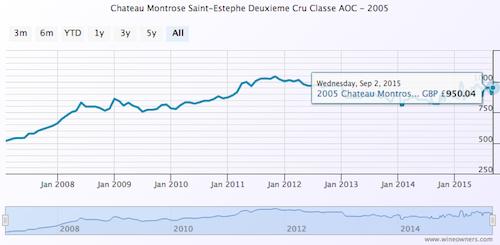
by Wine Owners
Posted on 2015-03-01
Today's excellent Matter of Taste event at the Saatchi gallery put on by the Robert Parker organisation highlighted to me that wines from so-called vintages overshadowed by great vintages may give far superior early to medium term pleasure than those more illustrious, fêted siblings.
Thinking back a year or so to previous tastings, Pontet Canet comes to mind. Take your pick from 2002, 2004 or 2006 for wines which today deliver great visceral pleasure (although the latter vintages are youthful) - whether you favour asian-spiced, sweetly grained and plump or delineated and pure fruit the choice (and preference) is yours. The dual powerhouses of 2009 and 2010 are incredibly dense wines, but today seem brutalistic and impregnable. Impressive as hell, they remain ébauches that Time, the master craftsman, is yet to shape.
A wonderful Masterclass led by Neal Martin and Alexandre Thienpont, winemaker and proprietor of Vieux Chateau Certan, further illustrated the point.
The surprise of the tasting was Vieux Chateau Certan 2006, which preceded the 2005.
A composed, peppery and dark-scented nose announced a medium weight, finely-woven, textured wine. Beautifully integrated, showing a firm core coated with a fine, sweet gloss, and a medium-long, insistent finish.
A delight to drink now, whilst giving the warmer, controlled, classically sauvage (iodine/ meaty) character of the 2005 another 5-10 years to achieve its unquestionable potential. In contrast the 2006 has an elegance and purity all of its own, and at a 20% discount to the 2005.
It's worth looking out for 'VCC' 2006 on the back of this showing. It's equally tempting to seek out more 2006s more generally, a vintage that had garnered some good reviews at first release, but which suffered in comparison to the more successful 2005 vintage across the Bordeaux region and due to release prices that were far too close to those of the previous year. Now almost a decade on, the fine, compelling character of the year is clear, and the pricing looks very fair.
Martin highlighted that Pomerol and St Emilion had enjoyed a particularly successful vintage in 2006. With that in mind, you may wish to check out the fine wine exchange for the following:
Lafleur Petrus
La Conseillante
Hosanna
Ausone
Marzelle
The wine of the 2006 vintage, Robert Parker and Jancis Robinson both proposed (in a rare show of unanimity), was Mission Haut Brion. Surely the price will never be as realistic as it is today, at around £1,250-1,350? (55%+ down from it's idiotic opening price that proved to be damaging to its secondary market performance). At least now this great wine is within reach of more wine lovers.
Mission Haut Brion
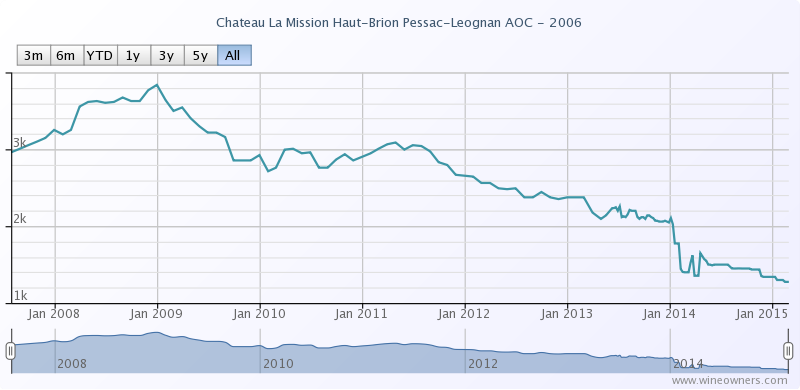
A somewhat under-the-radar La Mission, the 2006 was generally overlooked following the brilliance of the 2005. A young, dense purple-hued wine that is developing beautifully, it exhibits notes of Asian plum sauce, charcoal, barbecue smoke, roasted meats, graphite and background oak. Full-bodied with good acidity, moderate tannin and a vigorous, powerful youthfulness, the 2006 will age more quickly than the 2005, but it still requires another 5-8 years of cellaring. Anticipated Maturity: 2014-2035. (RP 2012)
Nick Martin
by Wine Owners
Posted on 2014-10-20
Why is there apparently so little wine in Bordeaux when so little of more recent vintages has been selling through? Why buy young wines at release? Will negociants’ balance sheets cope with more vintages that stick? Why would that happen?
Pontet Canet 2013 famously ‘sold out’ within an hour or two of being offered on the Bordeaux Place. Negociants sucked it up and took their allocations. That’s their historical role after all. Merchants generally weren’t having any of it. More relevantly, nor were their private clients. It was a lousy deal for the consumer: 2002, 2004 and 2006 are all cheaper vintages.
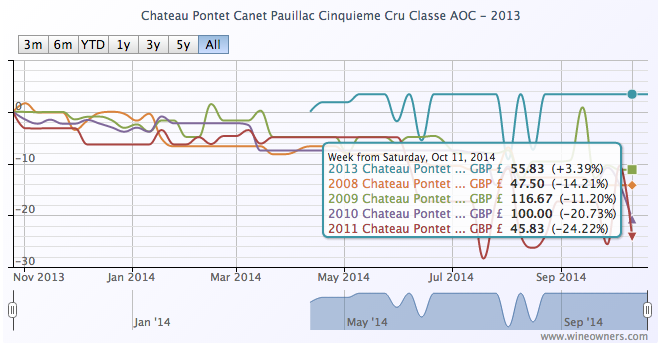
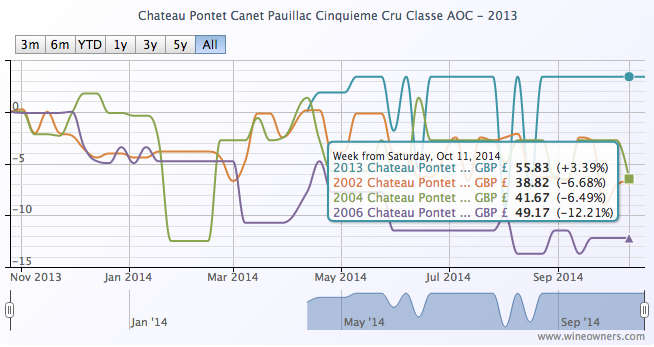
Now we’re on the cusp of a rather good vintage, the first in a small handful of years. Haut Brion 2008 has been trading at £2,400: a fair price for a lovely wine. To be a good buy, what will Haut Brion 2014 need to be offered to consumers for? £2,000? £1,900? £1,800? If instead it’s offered for £2,500, for example, what would be the point of buying it?
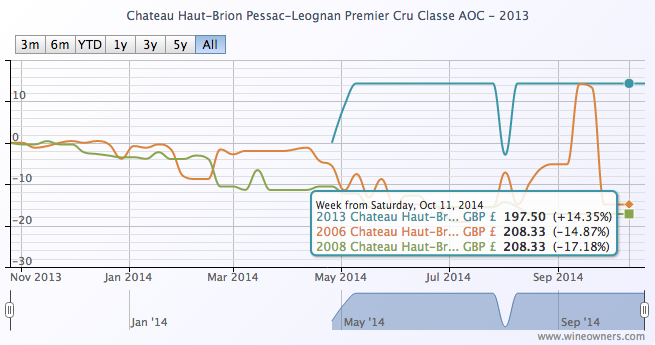
Loyalty? Surely not. Would consumers really want to play the stockholder for Chateaux that made extravagant profits out of 2005, 2006, 2009 and 2010 vintages? Some of who pillaged the European Union’s agricultural support fund during the bloody aftermath of Lehmann to construct a new chai or two? Buy into wines that might not drink for 15-20 years and might not be materially more expensive in 2 or 3 or more years’ time? Wines that are made in such benevolent quantities that finding them won't take more than a couple of minutes online? When there are so many back vintages that are coming back down to earth and are challenging our perceptions of value over the last few years?
So let’s imagine that the 2014 vintage proves a tricky sell. Not as thankless a job as the unloved 2013 vintage of course. The really big merchants who have an economic interest in en primeur to succeed and will sell the vintage: the weather, the brilliant Indian summer, the inevitable comparisons with the weather of 1996. Those cool nights, dewy mornings and balmy days under clear skies. But imagine it’s not what you might call a ‘successful’ campaign…
What happens then? How many of the negociants will be able to stomach another huge influx of stock without a corresponding outflux? With credit harder or impossible to come by; stalling European growth; a currency still fairly strong but with a significant downside, undermined by Europe’s recession-states, impatient creditors and a faltering Germany? With banks increasingly wary of lending support?
Of course some negociants will seize the moment to consolidate their position, increasing their market share as they gobble up distressed owners and their stocks. But others?
No one is yet disputing the efficiency of the negociant distribution system via the Bordeaux Place. After all, the huge Tuscan estates were sufficiently impressed by the system to want in. (And if you want your Libournais estate to be Classé, woe betide you if you try to circumnavigate the system.)
But it doesn't automatically follow that you have to believe in en primeur as long as it undervalues the consumer’s stockholding role to adhere to the established Bordeaux distribution model.
Passion-driven many of us may be, but perennially stupid we are not.
by Wine Owners
Posted on 2014-07-08
If a wine is from a first class vintage (serially dubbed ‘the vintage of the century’) and has scored a perfect or near perfect score, surely that wine is likely to give the greatest thrill; after all it’s considered the best that there is.
Or is it? If pleasure is what you're after, pulling a cork on highly–rated wine may be the most disappointing choice, especially if it’s from a relatively recent vintage.
Take the example of 1996 classed growth Medocs. Pontet Canet 1996 has impressive depth and purity that is currently held in check by a slowly receding tannic frame and enduringly fresh acidity. But one day it will surely be a very great wine.
Wines from so-called ‘off vintages’ (also known as restaurant vintages, shoulder vintages, an overshadowed by …. vintage) may give far superior current pleasure than its more illustrious, fêted siblings. Sticking with the Pontet Canet example, take your pick from 2002, 2004 or 2006 for wines which today deliver greater visceral pleasure; whether you favour Asian spiced, sweetly grained or delineated and pure fruit.
Switching to burgundy, surely great pinot noir doesn’t require the long wait of the finest red Bordeaux? Not so. Anyone who’s tasted the very best that 1999 has to offer will know how un-evolved, fruity and dense those wines still are. Sure, they impress with their texture and depth, but at the dinner table can disappoint with their primary-ness.
That peacock’s tail array of scent and flavour will one day burst out of the glass, seducing and beguiling the drinker. But today these wines merely provide waypoints to their future destination.
By contrast, the under-appreciated burgundy vintages of 1997, 1998 and 2000 provide some incredibly succulent current drinking, including Engel’s Vosne-Romanée Brûlées 1997, Ghislaine Barthod’s Chambolle-Musigny Les Cras 1998 and Denis Mortet’s Gevrey-Chambertin Champeaux 2000. There are countless others to pick from.
Thinking of arguably the greatest modern-era Italian, Roberto Conterno’s Monfortino, how can one compare the delicate 2002 with the blockbusting 1999? 2002 was a year in which most of sodden Piedmont suffered badly. Yet here is a sweet, perfectly poised wine showing soft red fruits and noble length. In contrast the 1999 is stunningly defined and intense, and a future monument for 10-20 years hence. But I’ll drink the 2002 now in preference.
What good is a cellar full of great vintages if you end up broaching so many of them in their infancy? Raise a glass for under-appreciated vintages. So often they will surprise and delight you, and may even win your best wines of the year awards!
Looking for ideas?
Leoville Barton 2002 - £450 (12x75cl) including duty and VAT

Montrose 2002 - £550 (12x75cl) ) including duty and VAT
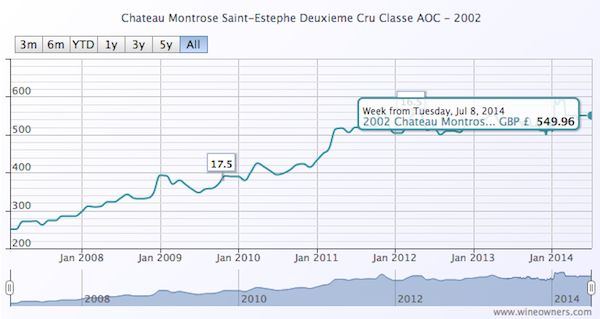
Malescot St. Exupery 2004 - £350 (12x75cl) In Bond

Louis Jadot Corton Les Greves Grand Cru 2001 - £150 (6x75cl) In Bond.
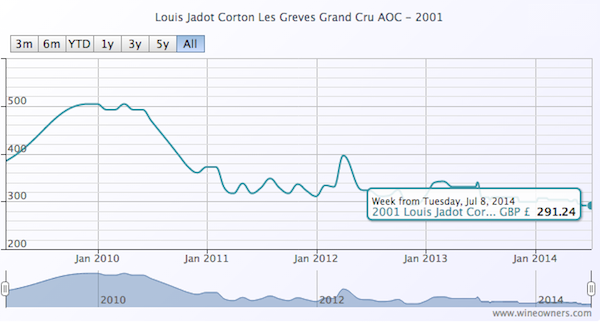
by Wine Owners
Posted on 2014-04-16
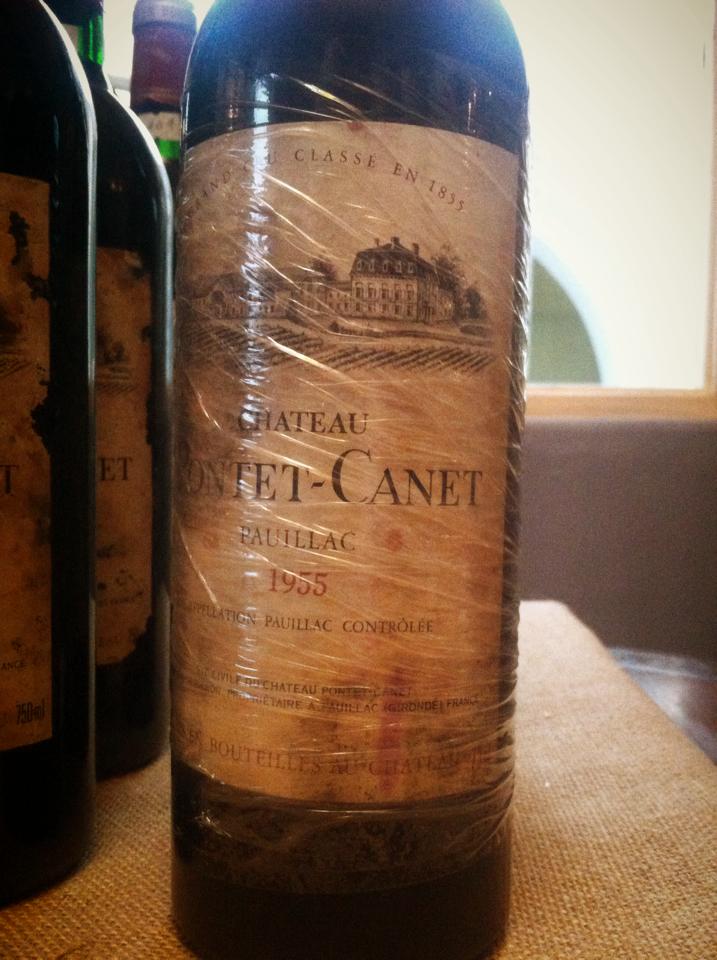
Nick Stephens is a respected wine expert with an international reputation as a critic and connoisseur. Nick was awarded the Prud'homme de la Jurade de Saint Emilion in 2007 for his work with the great chateaux and vineyards of that area. A devotee of the wines of Bordeaux, Nick has many years of insider knowledge and an array of chateaux owners, courtiers and negotiants that he does business with. Each year he visits Bordeaux for the En Primeur tastings held for the trade and reports back on the vintage in barrel. Also known as 'Wine Futures,' En Primeur is the opportunity to buy the wine before it is bottled (normally 18 – 24 months in the future) and released onto the market. Always hectic and often full of surprises the tastings are invaluable as they are the first indicator of the quality of the vintage. This year over 5000 wine merchants, brokers, critics, sommeliers and journalists from around 60 countries descended on Bordeaux for the event.
'This year Bordeaux En Primeur has attracted more comment and attention than expected, being even more agonised over than the boom years of 2010 and 2009. The 2013 vintage has been a trial for the Bordelais producers who have had to face severe weather conditions, reduced yields and rising production costs. If they had these difficulties twenty years ago most chateaux would not have been able to make a wine in such conditions. Thanks to advances in technology and increased expertise in vineyard management and in the chai wine was produced in 2013. The dry whites and sweet wines of Sauternes and Barsac are excellent but it is a different story for the reds. Overall they lack colour, complexity and depth. They will drink earlier than normal and 2013 is definitely not a speculators vintage.
Given that 2013 is a poor vintage for the Bordeaux red wines it is astonishing how much scrutiny they are commanding. Bordeaux has obviously not lost its appeal or its following.
But a spate of high priced years coupled with a run of mediocre vintages (2011, 2012 and 2013) means that wine enthusiasts and collectors need to look further afield. The best place to look for high quality Bordeaux reds is now in the past, in the back vintages of previous years and in particular 2008. In my opinion the 2008 wines are far superior in quality to more recent vintages and are more reasonably priced.
Over the past decade Bordeaux pricing hit two major price hikes and one minor. These occurred when good years were declared 'the vintage of the century'. The first was the 2005 vintage, the second with the 2009 and the third minor hike occurred with the 2010. The table below shows the release prices ex-negoce (to the trade) from a cross section of popular wines. At the time of writing the 2013 prices have only just started to be released. Pontet Canet, in an unprecedented move, released before the tastings had even begun.
|
Year
|
Margaux |
Parker Score |
Leoville Las Cases |
Parker Score |
Montrose |
Parker Score |
Pontet Canet |
Parker Score |
|
2004
|
96.00 |
93 |
50.00 |
93 |
31.80 |
91 |
24.50 |
90+
|
|
2005
|
460.00 |
98+ |
180.00 |
98 |
66.00 |
95 |
47.00 |
96+
|
|
2006
|
340.00 |
94+ |
125.00 |
95 |
51.00 |
94+ |
43.00 |
95+ |
|
2007
|
240.00 |
92 |
85.00 |
91+ |
45.00 |
91 |
43.00 |
91 - 94 |
| 2008 |
130.00 |
94 |
79.00 |
93 |
42.00 |
95 |
43.00 |
96
|
|
2009
|
550.00 |
99 |
216.00 |
98+ |
108.00 |
100 |
72.00 |
100 |
|
2010
|
600.00 |
99 |
192.00 |
96+ |
132.00 |
99 |
100.00 |
100
|
| 2011 |
360.00
|
94 - 96+ |
110.00 |
93 - 95+ |
72.00 |
91 - 93 |
66.00 |
93 - 95
|
| 2012 |
240.00 |
92 - 94 |
85.00 |
93 - 95+ |
57.60 |
92 - 94 |
60.00 |
91 - 94
|
| 2013 |
- |
- |
- |
- |
57.60 |
- |
60.00 |
-
|
As you can see from the table the 2008s hold their own in terms of quality with Parker scores being the equal or in some cases being higher, than those of 2007, 2011 and 2012 vintages. Scores for 2013 will not be released until Parker tastes the wines in June. A recent trade survey revealed that the industry itself believes the worst vintages in terms of quality regarding the First Growths are 2007 and 2013 whereas 2008 is considered the best. This is not surprising as the 2008 vintage represents good wine at a good price, despite the rise in value of some of the wines since their release. The wines are elegant, not over powering but with loads of fruit and well balanced tannins resulting in classic wines that can be drunk, savoured and enjoyed now or over the next three decades.
What happens to the En Primeur system itself if prices fail to drop for 2013 remains to be seen but savvy buyers can certainly find some lovely wines at good prices if they turn to overlooked vintages from decent years in the past.'
Nick Stephens
Prud'homme de la Jurade de Saint Emilion
Owner of www.bordeaux-undiscovered.co.uk and Fine Wine Merchants www.interestinwine.co.uk
by Wine Owners
Posted on 2014-04-02
Tucked away inside the Royal Opera Arcade off Piccadilly is a small, authentic bar à vin, the Pall Mall. This was the venue for the first ever Wine Owners event in association with our friends at Asset Wines, who are headquartered upstairs above the bar.
We are very proud to have co-hosted a vertical of Pontet Canet, among the very largest medocaine cru classé estates and the largest of Pauillac, yet arguably the most progressive - having risen far above their classified status whilst demonstrating leadership and foresight in investing heavily in uncompromising viticultural practises in the pursuit of excellence. Many of us have bought regularly upon release over the last 20 years, so it was an exciting prospect to be tasting across 4 decades of wine making evolution.
Thanks to Loric Gouban, Wine Owners’ popular new intern, we also had the pleasure of welcoming Justine Tesseron the daughter of co-owner Alfred, who introduced the Chateau and shared its history with the 30 wine enthusiasts assembled. Everyone was delighted she was able to join us and thoroughly enjoyed her company.
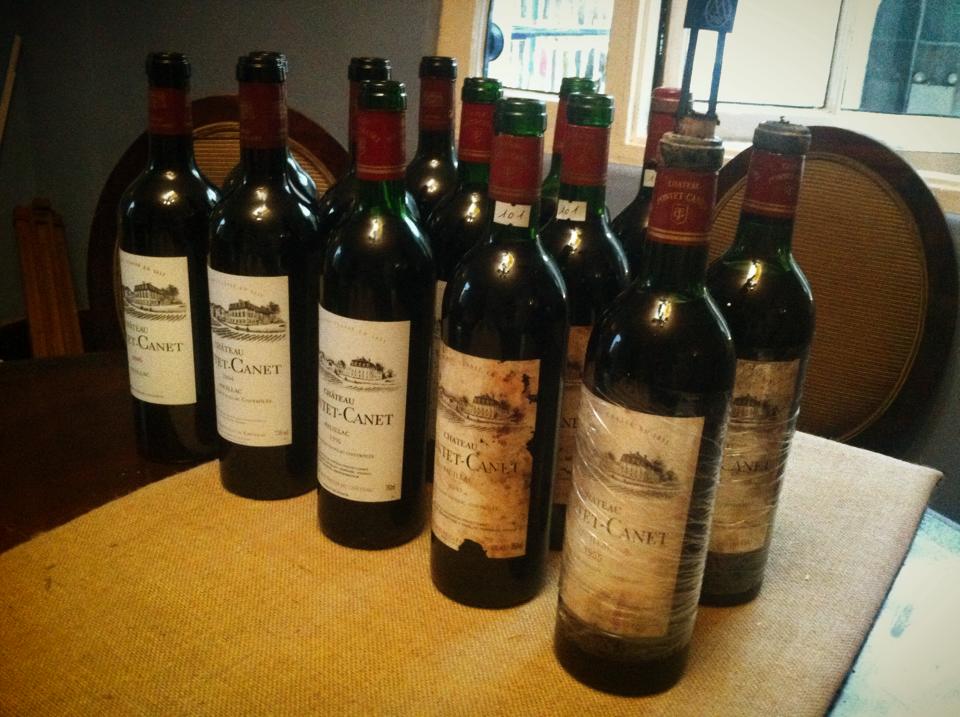
The first wine to be poured was 1985. At first blush it showed a fine cedar and bramble nose, and was a satisfactorily savoury wine. Frankly, it was served in the correct order of interest.
1996 had an immediately deeper nose, beautifully long to taste with fine powdery tannins, elegant but still taut and with the promise of more to come in another few years. The wine split the attendees, some of whom deeply admired its sinuous complexity, latent power and impressive length; whilst others were left wanted more fat. For a significant minority this was the most admired wine, although this may need some time to find its finest voice.
2004 was a very different expression. Ripe, intensely juicy and with sweet, tangible tannins delivering an impressive package of power, energy and seduction.
2006 proved to be an unexpected delight. Parker had advised his readers to ‘fill their boots’ and how right he was! Such poise and elegant fruit, this was really svelte with a pure finish. It perfectly intersected the youthful classicism of the 1996, and the juicy attention-grabbing fruit, sweetly tannic, crowd-pleasing 2004. At this point in the tasting this was for many the wine of the night. It has to be said, today this vintage sells for a great price (£600-£640) considering the very fine quality.
Then came the 1955, riskily presented as the last of the flight in the hope - rather than the expectation - of a bouquet finale. Never mind, we all said, it’ll be interesting at the very least and a privilege to taste. The bottles opened had both been re-corked at the property in 1989, and their labels were of the modern design in place of the original ‘Cruse’ versions. The understanding was that this ancient wine had spend its first 34 years in the cellars at Pontet Canet, before being reconditioned and sold. The wine turned out to be a monument. A soft, alluring nose was followed by the most mouthwatering palate, showing the complexity of age yet the freshness of something altogether younger, cupped in perfect balance with the most persistent of lifted fruit. In the glass the wine evolved over a 30 minute period, taking on more roundness with air and continuing to develop attractively to the last sip. Burgundian in texture and weight, what a way this was to finish such a convivial evening!
